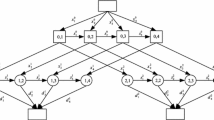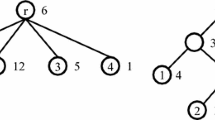Abstract
We consider the one-warehouse multi-retailer problem where a warehouse replenishes multiple retailers with deterministic dynamic demands over a horizon. The problem is to determine when and how much to order to the warehouse and retailers such that the total system-wide costs are minimized. We propose a new (combined transportation and shortest path based) integer programming reformulation for the problem in addition to the echelon stock and transportation based formulations in the literature. We analyze the strength of the LP relaxations of three formulations and show that the new formulation is stronger than others. We also show that the new and transportation based formulations are equivalent for the joint replenishment problem, where the warehouse is a crossdocking facility. We extend all formulations to the case with initial inventory at the warehouse and reveal the relation among their LP relaxations. We present our computational experiments with all formulations over a set of randomly generated test instances.
Similar content being viewed by others
References
Arkin, E., Joneja, D., & Roundy, R. (1989). Computational complexity of uncapacitated multi-echelon production planning problems. Operations Research Letters, 8, 61–66.
Chan, L. M. A., Muriel, A., Shen, Z. J. M., Simchi-Levi, D., & Teo, C. P. (2002). Effective zero-inventory-ordering policies for the single-warehouse multiretailer problem with piecewise linear cost structures. Management Science, 48, 1446–1460.
Denizel, M., Altekin, F. T., Süral, H., & Stadtler, H. (2008). Equivalence of the LP relaxations of two strong formulations for the capacitated lot-sizing problem with setup times. OR Spectrum, 30, 773–785.
Diaby, M., & Martel, A. (1993). Dynamic lot sizing for multi-echelon distribution systems with purchasing and transportation price discounts. Operations Research, 41, 48–59.
Eppen, G. D., & Martin, R. K. (1987). Solving multi-item capacitated lot-sizing problems using variable redefinition. Operations Research, 35, 832–848.
Federgruen, A., & Tzur, M. (1999). Time-partitioning heuristics: Application to one warehouse, multiitem, multiretailer lot-sizing problems. Naval Research Logistics, 46, 463–486.
Gao, L. L., Altay, N., & Robinson, E. P. (2008). A comparative study of modeling and solution approaches for the coordinated lot-size problem with dynamic demand. Mathematical and Computer Modelling, 47, 1254–1263.
Jin, Y., & Muriel, A. (2009). Single-warehouse multi-retailer inventory systems with full truckload shipments. Naval Research Logistics, 56, 450–464.
Kalymon, B. A. (1972). A decomposition algorithm for arborescence inventory systems. Operations Research, 20, 860–874.
Kırca, Ö. (1995). A primal-dual algorithm for the dynamic lot-sizing problem with joint set-up costs. Naval Research Logistics, 42, 791–806.
Krarup, J., & Bilde, O. (1977). Plant location, set covering and economic lot size: an O(mn)-algorithm for structured problems. In Numerische methoden bei optimierungsaufgaben, band 3: Optimierung bei graphentheoritischen ganzzahligen problemen (pp. 155–186). Basel: Birkhauser.
Levi, R., Roundy, R., Shmoys, D., & Sviridenko, M. (2008). A constant approximation algorithm for the one-warehouse multi-retailer problem. Management Science, 54, 763–776.
Nemhauser, G. L., & Wolsey, L. A. (1988). Integer and combinatorial optimization. New York: Wiley.
Pochet, Y., & Wolsey, L. A. (1994). Polyhedra for lot-sizing with Wagner-Whitin costs. Mathematical Programming, 67, 297–323.
Pochet, Y., & Wolsey, L. A. (2006). Production planning by mixed integer programming. New York: Springer.
Robinson, E. P., & Gao, L. L. (1996). A dual ascent procedure for multiproduct dynamic demand coordinated replenishment with backlogging. Management Science, 42, 1556–1564.
Robinson, P., Narayanan, A., & Şahin, F. (2009). Coordinated deterministic dynamic demand lot-sizing problem: A review of models and algorithms. OMEGA, 37, 3–15.
Stadtler, H. (1996). Mixed integer programming model formulations for dynamic multi-item multi-level capacitated lotsizing. European Journal of Operational Research, 94, 561–581.
Stadtler, H. (1997). Reformulations of the shortest route model for dynamic multi-item multi-level capacitated lotsizing. OR Spektrum, 19, 87–96.
van Hoesel, S., Romeijn, H. E., Morales, D. R., & Wagelmans, A. P. M. (2005). Integrated lot-sizing in serial supply chains with production capacities. Management Science, 51, 1706–1719.
Veinott, A. F. (1969). Minimum concave-cost solution of Leontief substitution models of multi-facility inventory systems. Operations Research, 17, 262–291.
Zangwill, W. I. (1969). A backlogging model and a multi-echelon model of a dynamic economic lot size production system—a network approach. Management Science, 15, 506–527.
Acknowledgements
The first author would like to thank the Scientific and Technological Research Council of Turkey for the scholarship provided during his Ph.D. The authors are also grateful to the referees for their comments that substantially improved this manuscript.
Author information
Authors and Affiliations
Corresponding author
Appendix
Appendix
1.1 A.1 Details of proof of Theorem 1
We show that (X,y) constructed using (39) belongs to F(SES) as follows:
-
(a)
Constraints (9): For 1≤i≤N,1≤k≤T, (16) is equivalent to (9). For i=0, 1≤k≤T, we sum (14) over all i and t and modify the summation bounds since q≤t≤k, which gives
$$\sum_{i=1}^{N}\sum_{t=1}^{k}\sum_{q=1}^{t}{W_{iqtk}} =\sum_{q=1}^{k}\sum_{i=1}^{N}\sum_{t=q}^{k}{W_{iqtk}} =\sum_{i=1}^{N}\sum_{t=1}^{k}{X_{itk}},\quad 1 \leq k \leq T.$$The term in the right-hand side above is equal to d 0k (\(=\sum_{i=1}^{N}{d_{ik}}\)) due to (16). Substituting X 0qk in place of \(\sum_{i=1}^{N}\sum_{t=q}^{k}{W_{iqtk}}\) due to (39) gives
$$\sum_{q=1}^{k}{X_{0qk}}=d_{0k},\quad 1 \leq k \leq T,$$which is equivalent to (9) for i=0,1≤k≤T. Thus, constraints (9) hold.
-
(b)
Constraints (10): For 1≤i≤N,1≤t≤k≤T, (17) is equivalent to (10). For i=0,1≤t≤k≤T, we sum (15) over all i, which gives
$$\sum_{i=1}^{N}\sum_{t=q}^{k}{W_{iqtk}} \leq \Biggl(\sum_{i=1}^{N}{d_{ik}}\Biggr)y_{0q} =d_{0k}y_{0q},\quad 1 \leq q \leq k \leq T.$$Substituting X 0qk in place of \(\sum_{i=1}^{N}\sum_{t=q}^{k}{W_{iqtk}}\) due to (39) gives
$$X_{0qk} \leq d_{0k}y_{0q},\quad 1 \leq q \leq k \leq T,$$which is equivalent to (10) for i=0,1≤q≤k≤T. Thus, constraints (10) hold.
-
(c)
Constraints (11): Summing (14) over t (from r=1 to t) and all i and k, we obtain
$$\sum_{i=1}^{N}\sum_{r=1}^{t}\sum_{k=r}^{T}\sum_{q=1}^{r}{W_{iqrk}} =\sum_{i=1}^{N}\sum_{r=1}^{t}\sum_{k=r}^{T}{X_{irk}},\quad 1 \leq t \leq T.$$Since q≤r≤t, we can rewrite the above equation as
$$\sum_{i=1}^{N}\sum_{q=1}^{t}\sum_{r=q}^{t}\sum_{k=r}^{T}{W_{iqrk}} =\sum_{i=1}^{N}\sum_{r=1}^{t}\sum_{k=r}^{T}{X_{irk}},\quad 1 \leq t \leq T.$$Adding a term to both sides, we have

The left-hand side of the above equation reduces to
$$\sum_{i=1}^{N}\sum_{q=1}^{t}\sum_{r=q}^{T}\sum_{k=r}^{T}{W_{iqrk}} =\sum_{i=1}^{N}\sum_{q=1}^{t}\sum_{k=q}^{T}\sum_{r=q}^{k}{W_{iqrk}},\quad 1 \leq t \leq T,$$which is indeed equal to \(\sum_{q=1}^{t}\sum_{k=q}^{T}{X_{0qk}}\) due to (39). Thus, it becomes
$$\sum_{q=1}^{t}\sum_{k=q}^{T}{X_{0qk}} = \sum_{i=1}^{N}\sum_{r=1}^{t}\sum_{k=r}^{T}{X_{irk}} + \sum_{i=1}^{N}\sum_{q=1}^{t}\sum_{r=t+1}^{T}\sum_{k=r}^{T}{W_{iqrk}},\quad 1 \leq t \leq T,$$which ensures that
$$\sum_{r=1}^{t}\sum_{k=r}^{T}{X_{0rk}}\geq \sum_{i=1}^{N}\sum_{r=1}^{t}\sum_{k=r}^{T}{X_{irk}},\quad 1 \leq t \leq T.$$Thus, constraints (11) hold.
-
(d)
To show that φ SES (X,y)=φ TP (W,X,y) for (X,y)∈F(SES) and (W,X,y)∈F(TP), we express φ TP (W,X,y) in terms of

Let the second term of the above expression be equal to
$$\sum_{i=1}^{N}\sum_{q=1}^{T}\sum_{t=q}^{T}\sum_{k=t}^{T}\Biggl(p_{0q}+\sum_{l=q}^{k-1}{h_{0l}}\Biggr)W_{iqtk} - \sum_{i=1}^{N}\sum_{q=1}^{T}\sum_{t=q}^{T}\sum_{k=t}^{T}\Biggl(\sum_{l=t}^{k-1}{h_{0l}}\Biggr)W_{iqtk}.$$Since q≤t≤k we can modify the summation bounds and we obtain

Using (39) for the first term and (14) for the second term above, we obtain
$$\sum_{q=1}^{T}\sum_{k=q}^{T}{H_{0qk}X_{0qk}} -\sum_{i=1}^{N}\sum_{t=1}^{T}\sum_{k=t}^{T}\Biggl(\sum_{l=t}^{k-1}{h_{0l}}\Biggr)X_{itk}.$$Then, replacing the above with the second term of φ TP (W,X,y), φ TP (W,X,y) becomes

which is equal to φ SES (X,y).
1.2 A.2 Details of proof of Theorem 2
We show that (W,X,y) constructed using (40) and (41) belongs to F(TP) as follows:
-
(a)
Constraints (14): Summing (26) over k (from j=k and j=T) and multiplying both sides by d ik , we obtain
$$\sum_{q=1}^{t}d_{ik}\sum_{j=k}^{T}{U_{iqtj}} = d_{ik}\sum_{j=k}^{T}{Z_{itj}},\quad 1 \leq i \leq N,1 \leq t \leq k \leq T.$$Substituting (40) and (41) into the above equation gives
$$\sum_{q=1}^{t}{W_{iqtk}}=X_{itk},\quad 1 \leq i \leq N,1 \leq t \leq k \leq T,$$ -
(b)
Constraints (15): Note that (41) can be rewritten as \(W_{iqtk}=d_{ik}\sum_{j=k}^{T}{a_{itj}U_{iqtj}}\) since a itj =1 for t≤k≤j≤T if d ik >0, otherwise W iqtk becomes zero. Then, we substitute W iqkt /d it in place of \(\sum_{r=t}^{T}{a_{ikr}U_{iqkr}}\) in (27), which gives
$$\sum_{k=q}^{t}{(W_{iqkt}/d_{it})} \leq y_{0q},\quad 1 \leq i \leq N,1 \leq q \leq t \leq T.$$Thus, constraints (15) hold.
-
(c)
Constraints (16): Summing (28) and (29) from t=2 to t=k, we obtain
$$\sum_{r=1}^{k}\sum_{j=k}^{T}{Z_{irj}} = 1,\quad 1 \leq i \leq N,1 \leq k \leq T.$$Substituting X irk /d ik in place of \(\sum_{j=k}^{T}{Z_{irj}}\) due to (40) gives
$$\sum_{r=1}^{k}{(X_{irk}/d_{ik})} = 1,\quad 1 \leq i \leq N,1 \leq k \leq T,$$ -
(d)
Constraints (17): Note that (30) can be rewritten as
$$\sum_{j=k}^{T}{a_{itj}Z_{itj}} \leq y_{it},\quad 1 \leq i \leq N,1 \leq t \leq k \leq T, $$(59)which actually encompasses (30). Equation (40) can be rewritten as \(X_{itk}=d_{ik}\sum_{j=k}^{T}{a_{itj}Z_{itj}}\), as done for W variables in part (b). Substituting X itk /d ik in place of \(\sum_{j=k}^{T}{a_{itj}Z_{itj}}\) in (59) gives
$$(X_{itk}/d_{ik}) \leq y_{it},\quad 1 \leq i \leq N,\ 1 \leq t \leq k \leq T,$$ -
(e)
To show that φ TP (W,X,y)=φ SP (U,Z,y) for (W,X,y)∈F(TP) and (U,Z,y)∈F(SP), we express φ TP (W,X,y) in terms of
$$\sum_{i=0}^{N}\sum_{t=1}^{T}{f_{it}y_{it}} + \sum_{i=1}^{N}\sum_{q=1}^{T}\sum_{t=q}^{T}\sum_{k=t}^{T}{H'_{0qt}W_{iqtk}} + \sum_{i=1}^{N}\sum_{t=1}^{T}\sum_{k=t}^{T}{H'_{itk}X_{itk}}.$$Substituting (40) and (41) into φ TP (W,X,y), we obtain
 (60)
(60)We can rewrite the second term in (60) as
 (61)
(61)We can rewrite the third term in (60) as
$$\sum_{i=1}^{N}\sum_{t=1}^{T}\sum_{k=t}^{T}\Biggl(\Biggl(p_{it}d_{ik}+\sum_{l=t}^{k-1}{h_{il}d_{ik}}\Biggr)\sum_{j=k}^{T}Z_{itj}\Biggr),$$which is equal to
 (62)
(62)Thus, summing the first term in (60), (61), and (62), we obtain
$$\sum_{i=0}^{N}\sum_{t=1}^{T}{f_{it}y_{it}}+ \sum_{i=1}^{N}\sum_{t=1}^{T}\sum_{k=t}^{T}\sum_{q=1}^{t}{H'_{0qt} D_{itk}U_{iqtk}} +\sum_{i=1}^{N}\sum_{t=1}^{T}\sum_{k=t}^{T}{G_{itk}Z_{itk}},$$which is equal to φ SP (U,Z,y).
1.3 A.3 Details of proof of Theorem 3
To show that \(\varphi_{\mathit{TP\hbox{-}JRP}}{(X,y)} =\varphi_{\mathit{SP\hbox{-}JRP}}{(Z,y)}\) for any \((X,y)\in F(\mathit{TP\hbox{-}JRP})\) and the associated (Z,y) \(\in F(\mathit{SP\hbox{-}JRP})\) or vice versa, we consider
which is equivalent to
We can insert V itk in place of X itk /d ik above regardless of the value of d ik since by definition V itk =X itk /d ik if d ik >0, and \((p_{it}+\sum_{l=t}^{k-1}{h_{il}})d_{ik}V_{itk}=0\) if d ik =0 (also p it d it V itt =0 if d it =0). So we have
Since d ik =D itk −D it,k−1 for t≤k−1, \(\sum_{k=t+1}^{T}(p_{it}+\sum_{l=t}^{k-1}h_{il})d_{ik}(V_{itk})\) equals to

Thus,
Rewriting the second term of the right-hand side of above equation, we obtain
Inserting Z variables using (45) and (46) to the above expression gives
which is \(\varphi_{\mathit{SP\hbox{-}JRP}}{(Z,y)}\).
1.4 A.4 Details of proof of Theorem 4
We show that (W,X,y) constructed using (57) and (58) belongs to \(F(\mathit{TP\hbox{-}I})\) as follows:
-
(a)
Constraints (15)–(17): They are already shown to be feasible in Theorem 2.
-
(b)
Constraints (50): Summing (54) over k (from j=k to j=T) and multiplying both sides by d ik , we obtain
$$\sum_{q=1}^{t}d_{ik}\sum_{j=k}^{T}{U_{iqtj}}+d_{ik}\sum_{j=k}^{T}{U_{i0tj}} =d_{ik}\sum_{j=k}^{T}{Z_{itj}},\quad 1 \leq i \leq N,1 \leq t \leq k \leq T.$$Substituting (57) and (58) into the above equation gives
$$\sum_{q=1}^{t}{W_{iqtk}}+W_{i0tk}=X_{itk},\quad 1 \leq i \leq N,1 \leq t \leq k \leq T,$$ -
(c)
$$\sum_{i=1}^{N}\sum_{t=1}^{T}\sum_{k=t}^{T}{D_{itk}U_{i0tk}} =\sum_{i=1}^{N}\sum_{t=1}^{T}\sum_{k=t}^{T}{(d_{it}+d_{i,t+1}+\cdots +d_{ik})U_{i0tk}} \leq I'_{00}.$$
The above inequality can be rewritten as

Substituting (58) for q=0 into the above expression gives
$$\sum_{i=1}^{N}\sum_{t=1}^{T}\sum_{k=t}^{T}{W_{i0tk}} \leq I'_{00}.$$Thus, constraint (51) holds.
-
(d)
To show that \(\varphi_{\mathit{TP\hbox{-}I}}{(W,X,y)} =\varphi_{\mathit{SP\hbox{-}I}}{(U,Z,y)}\) for \((W,X,y)\in F(\mathit{TP\hbox{-}I})\) and \((U,Z,y)\in F(\mathit{SP\hbox{-}I})\), we express \(\varphi_{\mathit{TP\hbox{-}I}}{(W,X,y)}\) in terms of
$$\varphi_{TP}{(W,X,y)}+\sum_{r=1}^{T}{h_{0r}I'_{00}} - \sum_{i=1}^{N}\sum_{t=1}^{T}\sum_{k=t}^{T} \Biggl(\sum_{r=t}^{T}h_{0r}\Biggr)W_{i0tk}.$$From Theorem 2, φ TP (W,X,y)=φ SP (U,Z,y), i.e.,

Since D itk U i0tk =W i0tk as shown in part (c) above, \(\varphi_{\mathit{TP\hbox{-}I}}{(W,X,y)}\) can be rewritten as
$$\varphi_{\mathit{SP}}{(U,Z,y)}+\sum_{r=1}^{T}{h_{0r}I'_{00}} - \sum_{i=1}^{N}\sum_{t=1}^{T}\sum_{k=t}^{T} \Biggl(\sum_{r=t}^{T}h_{0r}\Biggr)D_{itk}U_{i0tk},$$which is equal to \(\varphi_{\mathit{SP\hbox{-}I}}{(U,Z,y)}\).
Rights and permissions
About this article
Cite this article
Solyalı, O., Süral, H. The one-warehouse multi-retailer problem: reformulation, classification, and computational results. Ann Oper Res 196, 517–541 (2012). https://doi.org/10.1007/s10479-011-1022-0
Published:
Issue Date:
DOI: https://doi.org/10.1007/s10479-011-1022-0













